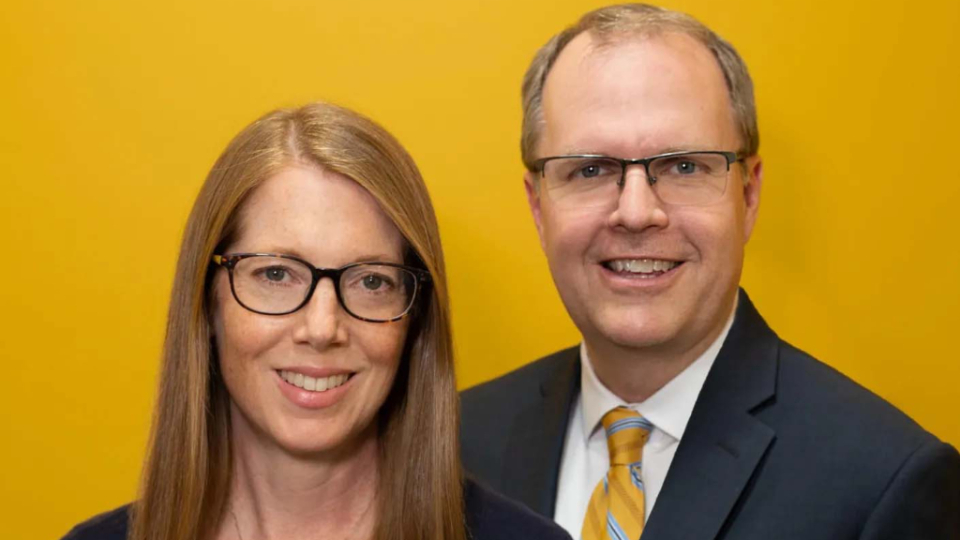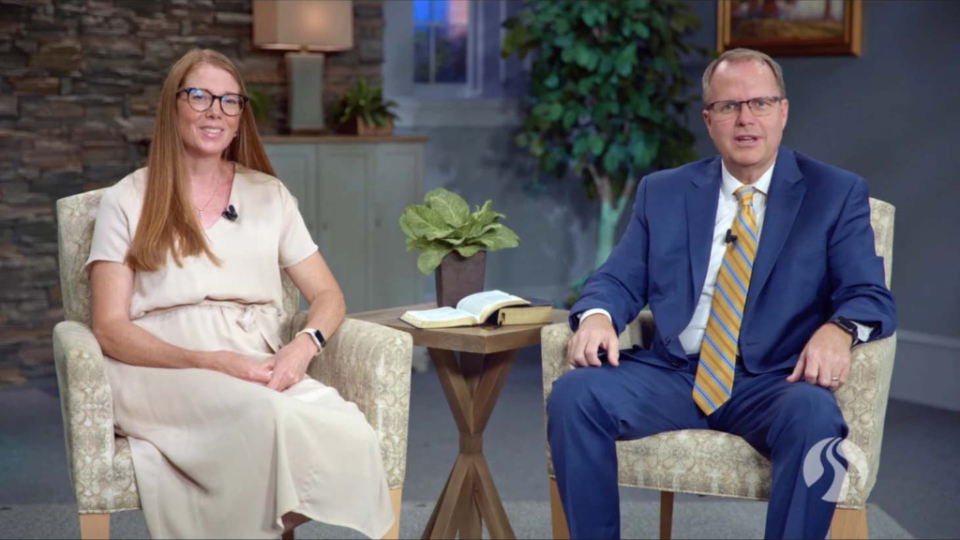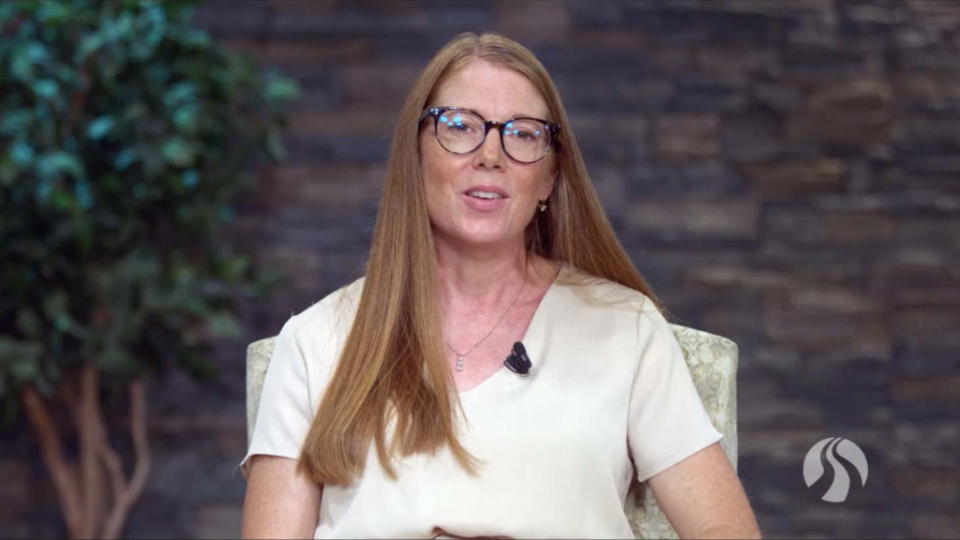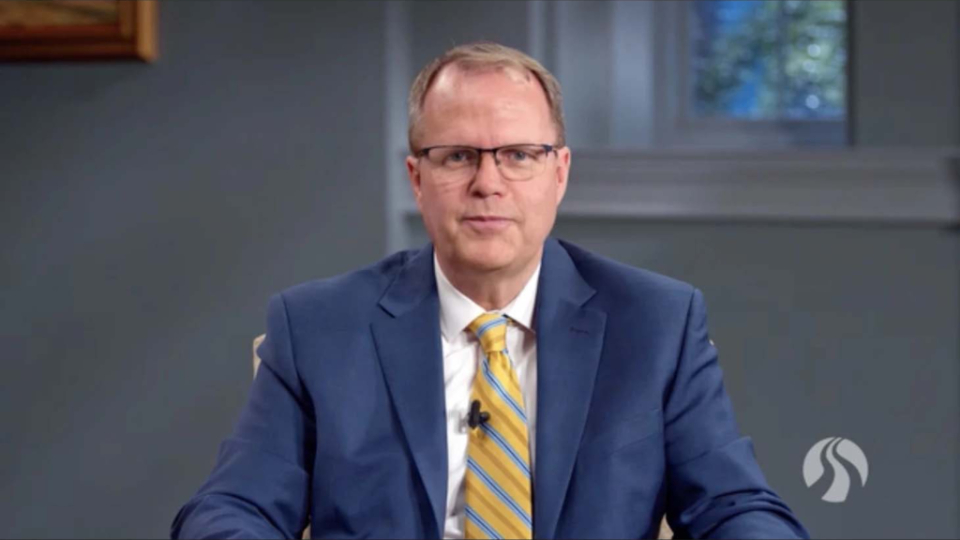
Ashtons-BYU-Pathway-1
BYU–Pathway Worldwide President Brian K. Ashton and Sister Melinda Ashton speak during the open devotional broadcast for the fall 2022 semester on September 20, 2022. Photo courtesy of byupathway.org, courtesy of Church News.All rights reserved.
This story appears here courtesy of TheChurchNews.com. It is not for use by other media.
By Rachel Sterzer Gibson, Church News
During BYU–Pathway Worldwide’s opening devotional for the fall semester, President Brian K. Ashton and his wife, Sister Melinda Ashton, spoke of the program’s integral role in helping to build Zion in the latter days.
“You were born on earth at this time to help build Zion,” President Ashton told students. “Your education at BYU–Pathway will help you to do so. This, in turn, will help prepare the world for the Second Coming of Jesus Christ.”
Sitting with her husband, Sister Ashton testified, “I know that creating Zion is not only God’s will for us but will bring joy and peace into our lives.”
What Is Zion?
Sister Ashton began her joint address with President Ashton by describing Zion.
Zion can be both a place and a people who are pure in heart, she explained. “In its fullness, Zion is both a people among which and a place where Jesus Christ would be comfortable dwelling” (see Moses 7:16, 64).
In the time after the Savior visited the Nephites, the people built a Zion society, Sister Ashton said. The scriptures describe it as a place where every man dealt justly, where there were no rich or poor and all were free, where great and marvelous works were performed by the disciples of Jesus Christ and where there was no contention “because of the love of God which did dwell in the hearts of the people” (4 Nephi 1:15).
“And there were no envyings, nor strifes, nor tumults, nor whoredoms, nor lyings, nor murders, nor any manner of lasciviousness; and surely there could not be a happier people ... but they were in one, the children of Christ, and heirs to the kingdom of God” (4 Nephi 1:16-18).
It would be “absolutely wonderful” to live in such a place, President Ashton noted, and prior to the Second Coming of the Lord, His people will have to build Zion anew.

Ashtons-BYU-Pathway-2
BYU–Pathway Worldwide President Brian K. Ashton and Sister Melinda Ashton speak during the open devotional broadcast for the fall 2022 semester on September 20, 2022. Photo courtesy of byupathway.org, courtesy of Church News.All rights reserved.
BYU–Pathway’s Role in Building Zion
Sister Ashton explained that Doctrine and Covenants 97 includes a list of requirements for Zion, including having a school, or schools, in Zion.
Elder Kim B. Clark, former commissioner of the Church Education System, taught, “BYU–Pathway is a school in Zion, wherever Zion is.”
“Therefore, the requirements in Doctrine and Covenants 97 and the responsibility to help build Zion apply to BYU–Pathway, its students, instructors, employees, missionaries and academic partners,” Sister Ashton said.
What is BYU–Pathway’s role in building Zion? President Ashton asked. Quoting Doctrine and Covenants 97, he said those associated with BYU–Pathway must have honest, broken hearts and contrite spirits, and observe covenants by sacrifice. BYU–Pathway must produce graduates who fulfill the program’s mission statement to be covenant-keeping “disciples of Jesus Christ who are leaders in their homes, the Church and their communities,” he said.
Sister Ashton shared how Moses 7:18 teaches, “the Lord called his people Zion, because they were of one heart and one mind, and dwelt in righteousness; and there was no poor among them.”
BYU–Pathway must also help students to learn to be of one heart and of one mind and to live righteously, Sister Ashton said. BYU–Pathway also has a unique role in ensuring there are “no poor among us.”
“No other Church institution has the worldwide reach and access to spiritually based, job-ready certificates and degrees like BYU–Pathway,” she said. “BYU–Pathway can provide higher education that will help our students get out of spiritual and temporal poverty in nearly every place that the Church is organized. Those students, in turn, can help others to become self-reliant until there are no poor among us.”

Ashtons-BYU-Pathway-3
Sister Melinda Ashton speaks during BYU–Pathway Worldwide’s opening devotional broadcast for the fall 2022 semester on September 20, 2022. Photo courtesy of byupathway.org, courtesy of Church News.All rights reserved.
Where to Start
BYU–Pathway’s instructors, missionaries, employees and academic partners must help students learn to build Zion in their lives, homes, congregations and communities, President Ashton said, by being pure in heart themselves and incorporating Zion principles into curriculum and teaching models.
“We invite each of you to examine your lives, teaching, curriculum and programs to see if they are in harmony with building Zion and then seek the Lord’s help to make necessary changes.”
Four Actions That Help Build Zion
President and Sister Ashton then discussed four things students must learn to do during their time at BYU–Pathway. “These things will help you become of one heart and one mind, live righteously, and lift out of spiritual and temporal poverty the poor among us. In doing so, you will help create Zion,” President Ashton said.
First, make and keep covenants with Jesus Christ and Heavenly Father.
“If you haven’t been baptized by someone holding the proper authority, we invite you to do so. … If you have been baptized but haven’t made covenants in the House of the Lord, we invite you to prepare to do so now. After making these covenants, we receive additional power to keep our covenants as we partake of the sacrament each week at church and return to the House of the Lord to do work for our ancestors,” Sister Ashton said.

Ashtons-BYU-Pathway-4
President Brian K. Ashton speaks during BYU–Pathway Worldwide’s opening devotional broadcast for the fall 2022 semester on September 20, 2022. Photo courtesy of byupathway.org, courtesy of Church News.All rights reserved.
Second, invite the Holy Ghost through praying and reading scriptures daily, repenting, avoiding contention, and serving others. “Doing these things, not as a checklist but with the intent to draw closer to Jesus Christ, will cause Jesus Christ to draw near unto you,” President Ashton said.
Third, follow the counsel of God’s living prophet on the earth — President Russell M. Nelson. The Lord has promised that He will inspire His prophet “to move the cause of Zion in mighty power for good ...” (Doctrine and Covenants 21:1–7).
“President [Russell M.] Nelson is doing that,” Sister Ashton said.
Fourth, persist in getting the education needed to support a family and have a successful career even when it is difficult.
“Having no poor among us begins with each individual developing the skills to be spiritually and temporally self-reliant. As we become self-reliant, we can bless others, including future generations,” President Ashton said.
Sister Ashton said there may be times when a student will be tempted to drop out of his or her degree program. “But if you will seek the Lord’s help, even when your situation seems impossible, He will provide you with hope and the means to continue on the timetable that is right for you,” she promised. “As you stay faithful to Jesus Christ, He will draw near unto you and help you to build Zion.”
In conclusion, President Ashton testified of Jesus Christ. “As our Savior and Redeemer, Jesus Christ wants to bless you both spiritually and temporally. He will come again. My prayer is that we will seek to build Zion by being of one heart and one mind, living righteously, and eliminating spiritual and temporal poverty.”
Copyright 2022 Deseret News Publishing Company.